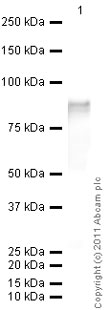Recombinant Human Annexin A10/ANXA10
| Product name: | Recombinant Human Annexin A10/ANXA10 |
| Source: | E. coli |
| Purity: | Greater than 95% as determined by reducing SDS-PAGE. |
| Buffer Formulation: | Lyophilized from a 0.2 μm filtered solution of 20mM PB,150mM NaCl,pH7.4. |
| Applications: | Applications:SDS-PAGE; WB; ELISA; IP. |
| Storage: | Avoid repeated freeze/thaw cycles. Store at 2-8 oC for one month. Aliquot and store at -80 oC for 12 months. |
| UOM: | 100ug/50ug/200ug/1mg/1g |
| Source | E. coli |
| Description | Recombinant Human Annexin A10 is produced by our E.coli expression system and the target gene encoding Met1-Tyr324 is expressed. |
| Names | Annexin A10, Annexin-10, Annexin-14, ANXA10, ANX14 |
| Accession # | Q9UJ72 |
| Formulation | Lyophilized from a 0.2 μm filtered solution of 20mM PB,150mM NaCl,pH7.4. |
| Shipping |
The product is shipped at ambient temperature. |
| Reconstitution |
Always centrifuge tubes before opening. Do not mix by vortex or pipetting. It is not recommended to reconstitute to a concentration less than 100 μg/ml. Dissolve the lyophilized protein in ddH2O. Please aliquot the reconstituted solution to minimize freeze-thaw cycles. |
| Storage |
Lyophilized protein should be stored at < -20°C, though stable at room temperature for 3 weeks. Reconstituted protein solution can be stored at 4-7°C for 2-7 days. Aliquots of reconstituted samples are stable at < -20°C for 3 months. |
| Purity |
Greater than 95% as determined by reducing SDS-PAGE. |
| Endotoxin | Less than 0.1 ng/µg (1 IEU/µg) as determined by LAL test. |
| Amino Acid Sequence |
GSHMFCGDYVQGTIFPAPNFNPIMDAQMLGGALQGFDCDKDMLINILTQRCNAQRMMIAEAYQSM YGRDLIGDMREQLSDHFKDVMAGLMYPPPLYDAHELWHAMKGVGTDENCLIEILASRTNGEIFQM REAYCLQYSNNLQEDIYSETSGHFRDTLMNLVQGTREEGYTDPAMAAQDAMVLWEACQQKTGEHK TMLQMILCNKSYQQLRLVFQEFQNISGQDMVDAINECYDGYFQELLVAIVLCVRDKPAYFAYRLY SAIHDFGFHNKTVIRILIARSEIDLLTIRKRYKERYGKSLFHDIRNFASGHYKKALLAICAGDAE DY
|
| Background | Annexin A10 (ANXA10) contains four Annexin repeats and is a member of the Annexin family. Members of this calcium-dependent phospholipid-binding protein family play a role in the regulation of cellular growth and in signal transduction pathways. It is reported that ANXA10 may be a clinical relevant marker for predicting outcome in both early and advanced stages of bladder cancer. |














